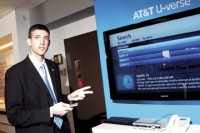AT&T Opens New Front in Arkansas Cable Wars
by January 12, 2009 12:00 am 69 views

The battle for television service subscribers continues to ramp up as a telecommunications giant recently introduced its U-verse system to a string of Northwest Arkansas communities.
The markets stretch from Bentonville, Rogers, Springdale and Fayetteville and jump down to Fort Smith and Barling in Sebastian County.
The U-verse platform allows AT&T to directly compete with cable companies for digital and high-definition television service and expands its bundled offerings beyond phone and Internet services.
“So far things are going well for them,” said Michelle Abraham, principal analyst for digital entertainment with In-Stat of Scottsdale, Ariz. “They had some snags when they first rolled out the system, but they seem to have worked out those early bugs.
“AT&T definitely is serious about it. That goes for all the telco companies who are competing for video.”
The Internet-Protocol-based U-verse system provides a network that links television, phone and Internet capabilities. The Total Home DVR feature allows simultaneous recordings of multiple shows and the ability to view recorded shows from any television connected to the household network.
The Northwest Arkansas move the first week of January pits AT&T Inc. of Dallas against Cox Communications Inc. of Atlanta and follows AT&T’s U-verse roll out in central Arkansas that began in September 2008.
“We of course keep an eye on what our competition is doing in the market,” said Kelly Zega, manager of public affairs for Cox Communications in Northwest Arkansas.
“At this point, I’m not aware of anything different we’re going to do. We try to price our product competitively while continuing to upgrade our product and add more and more services.”
If AT&T’s reception in central Arkansas is any indication, Northwest Arkansas consumers can expect a drop in pricing from Cox Communications. Anecdotal evidence also suggests that individual Cox subscribers will be able to haggle a better deal.
Comcast Corp. of Philadelphia became very open to negotiating deals with central Arkansas customers to keep them from leaving to AT&T.
Monthly mailouts of discount deals to former Comcast customers have followed.
AT&T touts that it has achieved a 10 percent-plus market share in less than 12 months after launching U-verse in a market. AT&T has brought additional pressure to bear with a 30-day money-back guarantee, a host of service options with no service contracts or installation charges.
“Customers in Northwest Arkansas will have another choice in TV, a very, very competitive product,” said Ryan Stafford, general manager of AT&T Arkansas and Oklahoma wired markets.
Based on current Cox Communications pricing, AT&T is deploying comparable or better services for less money through its U-verse system. The same can be said to a lesser extent for Comcast in central Arkansas.
However, cable companies retain their stake in offering the most blazing Internet speeds at the top-end of their menu.
Availability and accessibility are limiting factors for the U-verse system.
As with DSL Internet service, U-verse is not universally available. Even within neighborhoods, there can be voids of service availability. In general terms, that’s a function of proximity to AT&T’s fiber optic network.
“We continue to work on ways to extend our U-verse service,” said Stafford.
AT&T also has retained its relationship with Dish Network to offer satellite TV service to subscribers who don’t want U-verse or can’t get it.
Screening for credit worthy applicants is part of the norm for AT&T’s U-verse experience, with a trade-off of no deposits for equipment. Time will tell on how firm AT&T’s highly competitive pricing structure is.
In central Arkansas, AT&T is poised to increase some of its rates for specialty channel packages by $5 per month and for each additional non-DVR digital receiver by $2 per month effective Feb. 1.
Comcast’s latest marketing response to recapture lost customers and attract new ones in central Arkansas is an entry-level, triple-play offer of $80 per month for one year.
The line-up of television programming, Internet and phone service is comparable to a bundled U-verse package of $94.
Below the surface, the two choices appear to deliver about the same bang for the buck. But the edge easily would go to AT&T if video channels take precedence over audio stations.
In this package, Comcast offers a lineup of 90 stations, 40 of which are digital music stations. AT&T offers 100 stations, none of which are digital music stations.
One difference between the two offers is Comcast charges a nickel a minute for all domestic long-distance calls while AT&T provides 1,000 long-distance minutes monthly (more than 16 hours).
The fine print of the Comcast deal reveals a $3 monthly fee for internet/phone equipment and also indicates the $80 offer also doesn’t cover unspecified charges for equipment and installation.
A Comcast customer representative said the only other charge is a $40 installation charge. AT&T doesn’t charge any equipment or installation fees for a single digital receiver U-verse system.
“Our focus has been to increase value and improve the customer’s experience,” Mike Wilson, vice president of Comcast Cablevision of Arkansas Inc.
He cites high-definition programming as a prime battleground with AT&T, noting Comcast’s 43-channel HD offering plus more than 500 hours of HD programming on demand.
Wilson was surprised to learn that AT&T is laying claim to 85 HD channels through U-verse.
The U-verse system recently received highly favorable reviews from Consumer Reports for its television service. Its 76 rating was second only to Verizon’s FiOS service at 78 and ahead of Cox at 69 and Comcast at 58.
U-verse TV ranked “Highest in Residential Television Service Satisfaction in the North Central, South and West regions,” according to the J.D. Power and Associates 2008 Residential Television Service Provider Satisfaction Study.
AT&T topped the one million U-Verse subscriber mark last month after first launching the service in San Antonio in June 2006.
The competition for subscribers continues.
